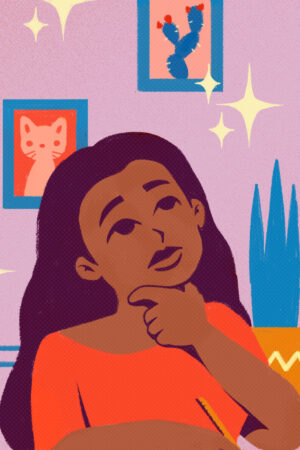These are the books we’re glued to right now.
Death In Her Hands by Ottessa Moshfegh
Likely best known for her 2018 novel, My Year of Rest and Relaxation, Moshfegh’s protagonists are lonely, depressed and unreliable—like the worst versions of ourselves verging on a panic attack. Moshfegh’s writing tiptoes on the edge of disgust and captures the mind of traversing a stress peak. But her latest, Death In Her Hands, isn’t a heavy read at all. The pages flip quickly as the reader goes deeper and deeper into the internal monologue of a widowed woman in her 70s living alone in a cabin in the woods. But this is no The Old Man and the Sea snoozer. When she discovers an anonymous note on her daily walk through the pines, the woman pulls a thread of a mystery that unfolds about her and before her.
“Her name was Magda. Nobody will ever know who killed her. It wasn’t me. Here is her dead body,” reads a little square of paper she finds tucked under a stone.
Fall is upon us and Halloween is nigh, but we’re still in a pandemic. If you, weary pandemic reader, are in need of escapism and a spooky vibe to set the tone, look to Ottessa Moshfegh’s work. –Francisco Navas
Basketball & Other Things by Shea Serrano
Some would say basketball is having a moment. For some, being transfixed by the idea of baloncesto is a year-round personality trait further enhanced by an interest in the inner workings of “the bubble” and the other precious, rather absurd details that make the NBA season possible at all this year. For others, it’s impossible to ignore its significance in the year of the legendary Kobe Bryant’s death and the release of ESPN’s docuseries The Last Dance. The game’s impact and influence on everything from fashion to young POC kids’ work ethic is undeniable and some, like Shea Serrano, have always been attuned to that.
In his third book, now in a hardcover, made-for-coffee-tables format, the writer and former teacher touches on the ins and outs of the game and its key players to date, devising a book that feels as if it was created for the ADHD mind—keen to be read out loud and out of order. Full of controversial takes on “greatest of all time” (GOAT) lists, this Arturo Torres-illustrated book comes just in time for 2020’s NBA Finals and debate-hungry dinner holiday tables. –Ecleen Luzmila Caraballo
Subculture: The Meaning of Style by Dick Hebdige
Trends and style are often deemed frivolous and ephemeral as the fashion industry regularly changes its mandates on what’s “in.” Author Dick Hebdige digs beneath the surface of fashionable exteriors by focusing on the philosophical and transmutational aspects of subcultural styles as a protest to cultural hegemony.
He dissects how the objects of style adopt and communicate meanings that continuously evolve over time, to function as both a reflection of the current cultural experience and play an active role in its development. Or, as Hebdige puts it, “whereby objects are made to mean and mean again.” He focuses on ‘70’s punk and other London based youth-protest movements, who developed their own “street-style” of turning common objects into cultural signifiers of their identity as a rebellion against the status quo.
This read speaks to how style serves as an act of resistance, formative expression of self and society, and a framework for “continuously studying and evaluating our relationships between all elements, in a whole way of life,” as Hebdige says. –Michaela Vargas Caro
Women, Race, and Class by Angela Davis
When Angela Davis published “Women, Race, and Class,” The Los Angeles Times Book Review stated it was “as useful an exposition of the current dilemmas of the Women’s movement as one could hope for.” Roughly four decades later, the book continues to remain relevant. The deep dive in women’s complexities and intersectionalities draws the historical context that links sexism, racism and class consciousness.
Malcolm X once famously said that “the most disrespected person in America is the Black woman.” This book expands on that thought, and demonstrates examples of the blatant racism that existed in the women’s liberation movement. Specifically, it touches on how feminism’s earliest figures—such as Elizabeth Cady Stanton, Lucretia Mott and Susan B. Anthony—endangered Black women and navigates topics such as racism in the woman suffrage movement, birth control, reproductive rights and more.
As injustices continue to prevail in our society, I find myself revisiting Davis’s past documentaries, interviews and books in which she defends poor folks and sheds light on capitalism’s exploitation, specifically how it hurts Black and Brown communities. –Jennifer Mota
Luster by Raven Leilani
In her debut novel, author Raven Leilani doesn’t shy away from creating a character that seems utterly unconcerned with people’s value judgments and troupes of likability. She gives her protagonist, a 23-year-old Black woman named Edie, the freedom to make bad decisions. Edie works at a publishing house in New York and eventually gets fired for sleeping with several of her colleagues. The novel then follows her into a complex relationship with Eric, a married white man who is in an open marriage, and his wife, Rebecca, who invites Edie into their shared home. From there, Leilani examines the tension between each character with a raw, unrelenting eye and even a sense of sharp humor. She wrote the book while getting her MFA at New York University (NYU), and the story she ultimately came up with is visceral and gripping from the first sentence—all qualities that explain why Buzzfeed called it “the next great millennial novel.” –Julyssa Lopez
Furia by Yamile Saied Méndez
When I found out that Argentine-American writer Yamile Saied Méndez was releasing a YA novel set in my hometown of Rosario, Argentina I was so excited to finally feel represented in the literary world where Latin Americans have long struggled for representation. Furia is an empowering story about multi-ethnic protagonist Camila “Furia” Hassan who aspires to be a soccer player but lives in a strict household that doesn’t see that as a possibility for a woman. She’s up against a machista, patriarchal society that sees soccer players (like fellow Rosarino Lionel Messi and Diego Maradona) as Gods and dismisses the possibility of a woman being able to be a skilled player. Her family unit is a microcosm for gender dynamics with an overprotective father and brother – a star soccer player – and homemaker and seamstress mother. In the background, there’s the presence of the effects of #NiUnaMenos, a feminist movement which started in Argentina as a response to violence against women and which Méndez weaves into the story including the symbolic green handkerchief. Furia’s soccer dreams are part of a grander dream of independence and success on her own terms and in the face of machista beliefs, it’s a testament to what it truly means to be a Latina poderosa. –Virginia Isaad







